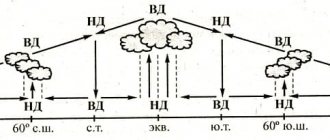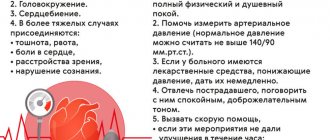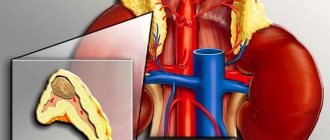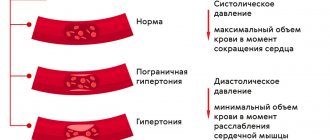People suffering from hypotension have low blood pressure. In men, the blood pressure level is 100/65 mm, in women – 95/60 mm. With hypotension, a person feels worse and their body temperature drops to 36 degrees. This occurs as a result of decreased vascular tone, insufficient blood supply and weakened heart function.
It happens that blood pressure is low and body temperature is more than 37–38 degrees. The causes of this condition can be infectious diseases, as well as a number of chronic pathologies, which the patient should pay attention to. To find out what factors provoked a decrease or increase in temperature during hypotension, you need to be examined by a therapist.
Causes of low body temperature
Exhaustion of the body
A slight decrease in temperature is observed with long-term dieting, when the body experiences a deficiency of energy compounds and important microelements.
All metabolic processes slow down, the activity of tissue respiration decreases, and contractile thermogenesis in the muscles becomes insufficiently effective. I am worried about constant weakness for no apparent reason, there are headaches and dizziness. Even with moderate physical activity, you quickly feel overworked. The skin is pale and cold to the touch. Temperature values are in the range of 34-35° C. Low temperature is a sign of exhaustion caused by grueling sports training or hard physical work. A person experiences weakness in the body, drowsiness, apathy.
Similar manifestations are characteristic of nervous exhaustion. With chronic stress, metabolic processes are disrupted and the body is unable to adapt to changing living conditions. Emotional disorders come to the fore; temperatures almost never fall below 34 degrees. You should see a doctor to rule out a more serious cause of hypothermia.
Hypothermia
Hypothermia occurs when wearing clothes that are too light during the cold season, staying in the cold for a long time, getting wet in the rain or falling into cold water. If body temperature is below 35° C, but above 32° C, mild hypothermia develops. During this period, there is a slight trembling throughout the body, the person tries to move his arms and legs to warm up. Due to active contractions of the masticatory muscles, the teeth begin to “chatter.”
The skin quickly acquires a bluish tint, which is most pronounced on the fingertips and face. At low temperatures within 28-32 degrees, the nervous system and metabolic processes are gradually suppressed. Due to the formation of a neuromuscular and vascular vicious circle, the body no longer maintains the temperature at the level necessary for life.
As the temperature drops, severe weakness, drowsiness, general lethargy increases, and hallucinations often begin. With severe hypothermia (less than 28 degrees), there is a high probability of respiratory and circulatory arrest. Failure to provide medical assistance at any stage of hypothermia is fraught with serious complications, including death.
Vegetative-vascular dystonia
Reduced body temperature during VSD is caused by impaired autonomic regulation and microcirculation disorders. Periods of hypothermia are characterized by weakness, trembling in the legs, and darkening of the eyes. If the patient is not helped in time, he may faint. Attacks develop periodically and are provoked by staying in a stuffy room, physical exertion, and prolonged stress. Symptoms occur more often in young, emotionally labile people.
Post-viral asthenia
During the recovery period after an infectious disease, a person’s body temperature drops below 36 degrees, which is associated with depletion of the body’s energy reserves and low activity of the immune system. Signs of hypothermia, increased drowsiness and symptoms of general malaise (weakness, fatigue, weakness) with post-viral asthenia persist for several weeks.
When walking fast or doing physical activity, you feel shortness of breath and your vision becomes dark. The duration of the period of low temperature depends on the severity of the infection and the body's reserve capabilities. Due to the lack of adaptive mechanisms in children, illness often lasts longer than in adults. Usually the condition improves gradually until the state of health and temperature are completely normalized.
Hypoglycemia
When blood sugar levels are less than 3 mmol/l, energy starvation of the brain and all tissues occurs, metabolism slows down, which causes a decrease in body temperature. At first, hypothermia is insignificant, weakness and dizziness are a concern, and profuse sweat appears on the skin. If the causes of hypoglycemia are not eliminated, the condition worsens and the temperature continues to decrease. With severe glucose deficiency, deep fainting occurs with a drop in the thermometer to 34° C.
Anemia
A decrease in body temperature is part of the anemic syndrome caused by low levels of hemoglobin and red blood cells in the blood. Temperatures are in the range of 34-35.5 degrees. Manifestations of hypothermia include increased fatigue, headaches, and “fly spots” flashing before the eyes. The appearance of hair deteriorates, nails crumble and break, and taste preferences change. The main causes of anemic syndrome:
- Deficiency anemia
: iron deficiency, B12 and folate deficiency. - Hereditary anemias
: sickle cell, thalassemia, Minkowski-Choffard microspherocytosis. - Posthemorrhagic anemia
: with profuse external bleeding, internal bleeding, hemorrhage in the body cavity. - Aplastic anemia
. - Hyperpolymenorrhea in women
.
Hypothyroidism
Insufficient production of thyroid hormones slows down metabolism and inhibits the effects of the brain's thermoregulation center. These reasons cause the appearance of a constant low temperature, independent of external factors. The skin with hypothyroidism becomes very pale, waxy, and hair falls out due to microcirculation disorders. Hypothermia is accompanied by lethargy, weakness, drowsiness during the day, and even after a long sleep a loss of strength is felt.
Addison's disease
Corticosteroids produced by the adrenal cortex increase metabolic processes and help maintain normal body temperature. When their production is insufficient, the first symptoms are chronic fatigue and drowsiness, which gradually intensify as adrenal insufficiency progresses and precede the appearance of other disorders.
Low body temperature develops against the background of systemic disorders caused by the pathological functioning of various organs and systems - a drop in blood pressure, tachycardia, muscle weakness. The combination of temperature readings less than 32-33 ° C, a sharp decrease in blood pressure, lethargy or loss of consciousness means the onset of Addisonian crisis - a serious condition requiring immediate medical attention.
Depression
In depression, changes in associative connections between the hemispheres and hyperactivity of the limbic system disrupt the functioning of the thermoregulation center. As a result, the body cannot maintain normal temperature. Temperature values rarely drop below 34.5° C, but hypothermia is prolonged. The skin, especially on the extremities, becomes cold, a marbled pattern appears due to capillary dysfunction, and pathological drowsiness is often a concern.
Pathology of the hypothalamus
With diffuse inflammation or hemorrhages in the hypothalamic region, a persistent drop in temperature below 32 ° C is typical, poorly controlled by warming. When the posterior hypothalamus is damaged, poikilothermia occurs - temperature fluctuations of more than 1 ° C associated with changes in the temperature characteristics of the environment. If a person with poikilothermia is exposed to a cold climate, they may experience a hypothermic coma with permanent brain damage.
Intoxication of the body
The accumulation of toxic compounds in the blood and their penetration into the brain disrupts the transmission of nerve impulses and the functional activity of brain tissue. Under the influence of toxins, body temperature decreases by 2-3°, the general condition quickly deteriorates - loss of consciousness and suppression of reflexes are typical. There is a waxy pallor and coldness of the skin, beads of sweat appear on the forehead. Such symptoms require emergency help to eliminate the cause of intoxication.
Emergency conditions
Temperature indicators rapidly decrease during shock conditions, when pathological expansion of superficial vessels occurs, and heat transfer increases several times. The general condition of the patients is extremely serious, body temperature drops 3-4 degrees below normal. Severe hypothermia combined with low blood pressure and chest pain indicates myocardial infarction.
The cause of low temperature can be ischemic stroke. When cerebral circulation is impaired, low temperature is accompanied by paresis of the limbs, sensitivity and speech disorders. Stunning, drowsiness, and short-term loss of consciousness are possible. A decrease in temperature and focal neurological symptoms usually increase gradually. In newborns, hypothermia is a consequence of asphyxia.
Complications of pharmacotherapy
Often, a low temperature is caused by taking psychotropic drugs that depress the central nervous system: barbiturates, benzodiazepines, clonidine. The side effect is associated with the suppression of muscle tremors and a decrease in heat production; due to the expansion of skin capillaries, the body quickly loses heat. Medicinal causes cause hypothermia only when dosages are not observed or when maximum doses are deliberately taken. An overdose of tablets leads to stupor or first degree coma.
Rare causes
- End-stage liver failure
. - Sepsis and septicopyemia
. - Comatose states
: diabetic ketoacidosis, uremia, lactic acidosis. - Iatrogenic factors
: failure to maintain thermal balance during operations, low temperature in intensive care wards. - Spinal cord injuries
: spinal cord injury, tumors, syringomyelia.
Dangerous factors of changes in thermometer readings
Normal body temperature is 36.6 degrees (in the evening this figure can rise to 37 degrees). Normal blood pressure is around 120/80 mmHg.
But sometimes these values decrease or increase. At the same time, your well-being changes. The reasons for deviations may be different.
One of the most harmless ones is fatigue. But often the condition worsens with the development of serious illnesses. The speed of biochemical reactions depends on the level of thyroid hormones. If, for no apparent reason, a person begins to suffer from weakness and low blood pressure, this indicates the presence of endocrine disorders. At the same time, weight changes, apathy and memory impairment are also observed.
Diabetes mellitus is accompanied by a decrease in the rate of glucose oxidation. As a result, body temperature drops slightly. This pathology is also characterized by frequent urge to urinate, severe thirst, and decreased sensitivity in the legs and arms.
If you experience low body temperature and high blood pressure at the same time, this may indicate the presence of liver disease.
This condition is explained by the fact that the body’s ability to absorb carbohydrates is reduced.
The glycogen content in the blood decreases. A deficiency of this substance is perceived by the body as a critical situation. The response is to try to reduce energy expenditure by lowering body temperature.
People who suffer from heart failure usually experience low blood pressure, low temperature, weakness, and dizziness. A slightly low temperature with unstable blood pressure may be the first symptom of developing oncology. Over time, the thermometer and tonometer readings drop even lower due to weakening of the body.
Sometimes low temperature and blood pressure occur after taking sedative medications. Long-term use of certain medications leads to a weakening of the human body and a decrease in the tone of the walls of blood vessels.
So, low or high blood pressure and low body temperature may have different causes. If this condition continues for more than three days, it is recommended to consult a doctor. Timely diagnosis and treatment will help quickly eliminate the unpleasant manifestations of the disease and avoid complications.
Diagnostics
A patient with thermoregulation disorders is examined by a general practitioner or emergency physician (in case of critical hypothermia). The scope of diagnostic measures depends on the patient’s condition and the degree of temperature decrease. At values above 32°C, advanced laboratory and instrumental studies can be performed to identify the cause of hypothermia; at lower values, they are limited to basic methods. The most informative:
- Physical examination
. First of all, to detect the cause of a person’s low body temperature, thermometry is performed. Temperature is most often measured in the rectum; an esophageal probe is used to obtain accurate information about the internal temperature. To assess consciousness, the integrity of the pupillary and pain reflexes is checked. - Blood tests
. The basic checklist includes measuring glucose, red blood cells and hemoglobin levels. A biochemical blood test can reveal high levels of nitrogen and urea, laboratory symptoms of liver disease. To diagnose anemia, the amount of free iron, ferritin and transferrin is determined. - Hormonal profile
. To exclude pathologies of the thyroid gland, the content of thyroxine and free T3, thyroid-stimulating hormones of the pituitary gland are taken into account. You also need to examine the amount of adrenal hormones and catecholamines. To confirm Addison's disease, an ACTH stimulation test and information about the levels of essential electrolytes are required. - Electrographic methods
. An ECG is recommended for all patients, which allows detecting pathognomonic signs - Osborne wave, prolongation of the PQ and QT intervals. To assess the functional activity of the brain, an EEG is prescribed. In a hospital setting, electromyography and electroneurography of peripheral nerve trunks are sometimes performed. - X-ray imaging
. A CT scan of the brain is the first thing to do to rule out central causes of low body temperature. The images may reveal mass formations or possible swelling of the hypothalamic region. Scintigraphy of the thyroid gland with iodine isotopes helps to study the structure of the organ in more detail.
Thermoregulation in the body
For normal human life it is necessary that heat exchange be carried out constantly. It depends on the characteristics of the organism and on the presence of various reflex stimuli, and changes can have an effect even if the ambient temperature remains unchanged.
Violation of thermoregulation
First of all, such violations can occur as a result of exposure to external or internal factors. For example, internal diseases include various types of diseases.
The main symptoms can be considered:
- chills;
- chills, as a result of hyperkinesis - when involuntary muscle contractions occur;
- as a result of hypothermia - the consequences of hypothermia;
- as a consequence of hyperthermia - in case of overheating of the body.
The main causes of thermoregulation disorders are:
- congenital or acquired defect of the hypothalamus. It can negatively affect the functioning of many internal organs, including body temperature itself;
- climate change. This external factor is capable of influencing body temperature as a result of adaptation of the body;
- alcohol abuse;
- a consequence of processes associated with aging;
- various mental disorders.
Treatment
Help before diagnosis
If the body temperature is more than 32°, you can get by with passive warming. The person is wrapped in heated blankets or placed in a bath with warm water and given hot tea. With prolonged hypothermia and satisfactory condition during the convalescence period, specific treatment is not required - sleep 8-10 hours a day, increased calorie intake, and adequate rest are recommended. If the reasons for the detected low temperature are unclear, consult a doctor.
First aid for hypothermia
Conservative therapy
At critically low temperatures, active warming is effective: heat fans and heating pads, inhalation of warm humidified oxygen and intravenous infusion of heated solutions. In emergency situations, warm lavage and extracorporeal blood purification methods are used. For etiotropic and pathogenetic treatment of diseases accompanied by a drop in human body temperature below 36 degrees, the following are prescribed:
- Vitamins
. With general exhaustion of the body, B vitamins are indicated, which enhance neuromuscular transmission and improve the trophism of nervous tissue. Alpha tocopherol is used as a powerful antioxidant. For severe weakness, glucose solutions with vitamin C are administered. - Hormones
. Replacement therapy with levothyroxine allows you to accelerate the processes of metabolism and thermogenesis, and restore normal body temperature. In case of Addison's disease, cortisol preparations are necessary; in case of a lack of mineralocorticoids, aldosterone is additionally administered. - Cardiotropic drugs
. Medicines stimulate cardiac activity in shock and other critical conditions, normalize cardiac output and increase blood pressure. The drugs of choice for emergency care are solutions of adrenaline or dobutamine; in hospital therapy is supplemented with glycosides. - Antidepressants
. The medications are serotonin receptor agonists and improve neural connections between different parts of the brain. Temperature normalization occurs due to stimulation of the hypothalamic center and increased contractile thermogenesis. - Antibiotics
. Hypothermia often masks the manifestations of a severe bacterial infection, so broad-spectrum antibiotics are indicated for very low body temperatures. Medicines are administered intravenously until temperature values normalize and general condition improves. - Antidotes
. For acute signs of intoxication, universal drugs are used that bind or destroy various toxic substances. In cases of heavy metal poisoning and drug overdose, unithiol is effective.









